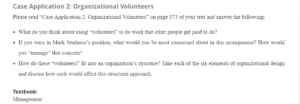Organizational Volunteers
What do you think about using “volunteers” to do work that other people get paid to do?
Organizational volunteering is a source of labor for both non-profit and for-profit organizations in the US and around the world. Volunteers are motivated to join volunteer programs with the objective of being absorbed into the organization’s workforce at the expiry of their volunteer or training program. Others take up volunteer positions through company-lead strategies that use incentives for customers to self-serve. As consumers become independent with advancing technologies and connections, the appeal of customer reviews is increasing. Companies that apply this strategy, like Verizon, engage in exploitative and unethical methods for services they would otherwise have paid people or deployed equipment to handle. Customer exploitation is uninhibited through the manipulative digital marketing strategies used to reach out to clients. Once a client decides to purchase a product from an online retailer, the product vendor requires them to create an account that requires email verification. The customer will then review individual data on a massive scale to come up with a cheaper solution. As a result, the company cuts on the human resource spending for recruitment and recurrent salaries. With a simple award system, such as using categories (Silver, Platinum, Gold), companies deny qualified candidates an opportunity to dispense professional service.
If you were in Mark Studness’s position, what would you be most concerned about in this arrangement? How would you “manage” that concern?
Mark Studness should be more concerned with ethical practice compliance at the organizational and external levels. I would embark on a transformative organizational change management that will implement measures for the organization to adhere to set down legislation, policy guidelines, and tax compliance issues for any worker at the company. In a bid to maintain a growing business, I would implement a consultative monetary rewards system that motivates dedicated problem solvers in the company’s customer relations department.
How do these “volunteers” fit into an organization’s structure? Take each of the six elements of organizational design and discuss how each would affect this structural approach.
Work Specialization – the organization will have to implement a decentralized management approach to accommodate the integrated role of customer roles for the business.
Departmentalization and compartmentalizing – volunteers will be categorized under customer service for increased participation in client-initiated discussions.
Chain of command – it remains unclear how increasing participation of customers in solving solutions for the company will be sustained in the end. Customers switch product shopping preferences or stop using specific websites (Biran et al., 2021). Establishing a chain of command to an unsupervised human resource reserve may require filler recruitments for emergency problems and solutions for clients.
Span of control – the organization will have a span of control to a limited level of company participants. It will be difficult to dictate to free customers what time and problem they must solve since the arrangement is on a willing basis (Haugh, 2021).
Centralization and decentralization – The organization must centralize core management sectors of the work assignment. However, customer relations and the sales department have a window for stepping out of the rule book.
Formalization elements – it will be difficult to formalize a will-based dedication to contributing to solutions to complaints, queries, and best practices.
References
Biron, M., De Cieri, H., Fulmer, I., Lin, C. H. V., Mayrhofer, W., Nyfoudi, M., … & Sun, J. M. J. (2021). Structuring for innovative responses to human resource challenges: A skunk works approach. Human Resource Management Review, 31(2), 100768.
Haugh, H. M. (2021). Social economy advancement: from voluntary to secure organizational commitments to public benefit. Journal of Management History.
Robbins, S., & Coulter, M. (2017). Management, Global Edition (14th ed., p. 373). Pearson Education, Limited.
ORDER A PLAGIARISM-FREE PAPER HERE
We’ll write everything from scratch
Question
Case Application 2: Organizational Volunteers
Please read “Case Application 2: Organizational Volunteers” on page 373 of your text and answer the following:

Organizational Volunteers
- What do you think about using “volunteers” to do work that other people get paid to do?
- If you were in Mark Studness’s position, what would you be most concerned about in this arrangement? How would you “manage” that concern?
- How do these “volunteers” fit into an organization’s structure? Take each of the six elements of organizational design and discuss how each would affect this structural approach.
Textbook:
Stephen P. Robbins and Mary Coulter, 2018
Pearson Education
ISBN.13: 978-0-134-52760-4

